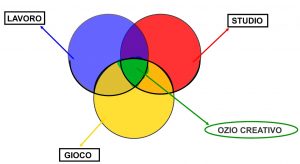What about wellness and happiness?
When I thought of talking about time management, I realized that the interest in the topic is proportional to the amount of information available online: huge. I have also discovered, however, that the topic in its complexity is treated most of the time with a single narrative: productivity and success. Is that really all there is to it? I share what has inspired me, what I have tested, and what I recommend. The rest is in your hands.
- Time management: productivity and success
- Time management: control and “ozio creativo” (creative leisure)
- The most important thing to start with
1) Time management: productivity and success
Try to Google “time management,” or even better, “how to better manage my time,” and you will find a world of information. It is a query that brings with it answers full of suggestions, advice, rules, and techniques. These answers showcase a specific kind of person: super-productive, successful winners—those we would all like to resemble.
It’s all very interesting. It’s all very obvious. Everybody wants to look in the mirror and see someone cool, successful, rich, happy, etc. Isn’t that right?
But we should take into consideration that all these tips, advice, and rules for increasing productivity could be challenging to apply in everyday life. They are usually offered in a vacuum, and applying them could feel a bit like jumping out of your comfort zone. Sometimes we want to make these kinds of changes—sometimes we have to—but there is a risk of getting lost in the preparations or to waiting too long to act.
If you are ready to jump in and challenge yourself to a greater extent, I suggest you look for some inspiration here:
Personally, I have always been fascinated by the idea of optimizing my time, and I have always experimented with different methods.
I still remember when I learned for the first time about Henry Ford and Taylorism, the theory concerning management put forth by Frederick Winslow Taylor in his 1911 monograph The Principles of Scientific Management.
I was so impressed with these ideas that I spent a whole period of my life experimenting to find the best technique to load the dishwasher or set the table. You have no idea of how many applications of the principles of scientific management you can find at home!
I have always considered having a method, a structure, and being organized to be valuable tools that we can apply in very different contexts. Some of them are definitely related to productivity but others—shake-up time—are related to our personal lives with all their fascinating and complex nuances.
So I started asking myself: Is it possible to change the narrative behind the traditional way of looking at time management? Is it just a question of productivity and success, or is there something else?
2) Time management: control and “ozio creativo” (creative leisure)
I am trying to shake things up by sharing with you that I strongly believe that time management is not just a question of productivity and success. I would say that it is (at least) also a question of control and creative idleness.
Control
Laura Vanderkam, in her TED Talk, “How to gain control of your free time” offers a very interesting perspective on control when she says:
“We don’t build the lives we want by saving time. We build the lives we want, and then time saves itself.”
“That time is highly elastic. We cannot make more time, but time will stretch to accommodate what we choose to put into it.”
“The key to time management is treating our priorities as the equivalent of that broken water heater.
… Everything I do, every minute I spend, is my choice. ‘I don’t have time,’ often means ‘It’s not a priority.’ If you think about it, that’s really more accurate language.”
Time is a choice is for me the most powerful statement of the entire speech. It’s a true source of inspiration, a mantra that we should continually repeat to ourselves.
I also do agree very much with the concept of priorities.
Vanderkam suggests to identify priorities in three domains: career, relationships, ourselves. First, we need to understand what our priorities are—not those of someone else but our own. Those we care about the most. This should be a short list of two or three items per category.
Priorities must be included in our plan. We are not talking about New Year’s plans or medium- / long-term plans. With a more pragmatic and practical approach, let’s talk about a plan for the following week to prepare before it starts.
Laura suggests working on the list of priorities on Friday. I like to do that on Sunday. If you ever want to experiment with this method, look for your ideal solution as well, but one thing is certain: do it before the beginning of the week!
It may be useful to repeat a second mantra: there is time.
“It’s about looking at the whole of one’s time and seeing where the good stuff can go. I truly believe this. There is time. Even if we are busy, we have time for what matters. And when we focus on what matters, we can build the lives we want in the time we’ve got.”
Time management is not just a question of productivity and success. It is also a question of control (based on our priorities) and of creative idleness (let’s talk about that next).
Ozio Creativo (creative leisure)
My experimentation on the scientific management of housework began to evolve when I learned about the Italian sociologist Domenico De Masi and about the concept he developed called “ozio creativo.” (I was unable to find an English equivalent, so I will do my best to try to explain it). According to Wikipedia, ozio creative can be explained like this:
“In post-industrial society where creativity predominates over dexterity (manual skills), the boundaries between work, study and play are mixed up. This merger generates creative idleness, a situation in which one works without being aware of doing it.
The term ‘idleness’ must not make one think of a situation of passivity. For the ancient Romans the term ‘otium’ did not mean ‘dolce far niente,’ but rather a free time from the commitments in which it was possible to open up to the creative dimension.
In today’s society most of the repetitive and boring jobs have been delegated to the machines; man has remained the monopoly on creativity.”

Photo credit: sociologicamente.it
The concept was deployed in 1995, long before we were talking about digital disruption and the fourth industrial revolution, when the size and the speed of the world in which we lived were not even remotely comparable to what they are now.
Yet the combination of the three dimensions of what De Masi defines as ozio creativo—the work with which we produce wealth, the study with which we produce knowledge, and the play with which we produce joy—could not be more relevant today after over twenty years.
I consider the concept of ozio creativo a great summary able to express the fascinating and complex nuances of our life that completes the vision focusing exclusively on productivity and success.
De Masi’s three dimensions—work, study, play—and the three dimensions that Laura Vanderkam mentions in her TED Talk—career, relationships, ourselves—have a common denominator: they suggest looking at time and its management from a holistic point of view not necessarily tied only to productivity and success.
When it comes to time management, it’s time to shake up our approach. Productivity and success are OK, but they are not enough. We should expand the concept of time management to include taking control of our time to serve our priorities (“Time is a choice / There is time”) and to include “ozio creativo”, the idea of thinking about our time in the categories of “work, study, play.”
3) The most important thing to start with
If you have read this far, you will have noticed that I have not (yet) talked about suggestions, rules, and techniques. And I do not intend to do it—at least not here, at least not now.
Instead of pre-packaging a long list of things to do, I think the most important thing to start with is just one: to think, to meditate.
This is where I started. I started my journey of improving my ability to manage my time by thinking deeply.
Please allow me to provide you with the following suggestion.
Take some time for yourself.
Look at the TED Talk. Meditate on the value of ozio creativo. Do some more research.
Stop and think.
Meditate on your life.
Meditate on your priorities.
The “how” of managing your time will follow.
Photo by Houcine Ncib on Unsplash





